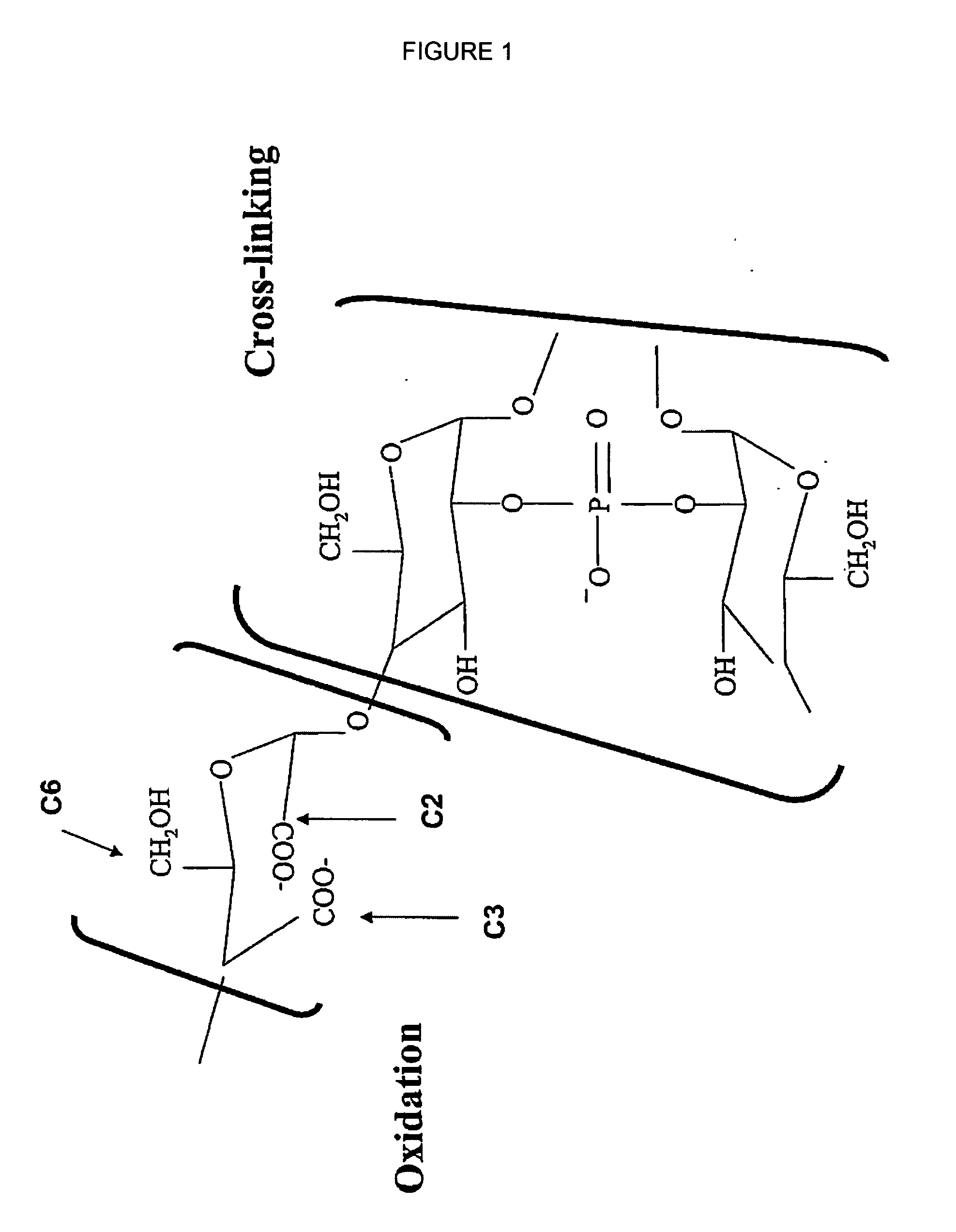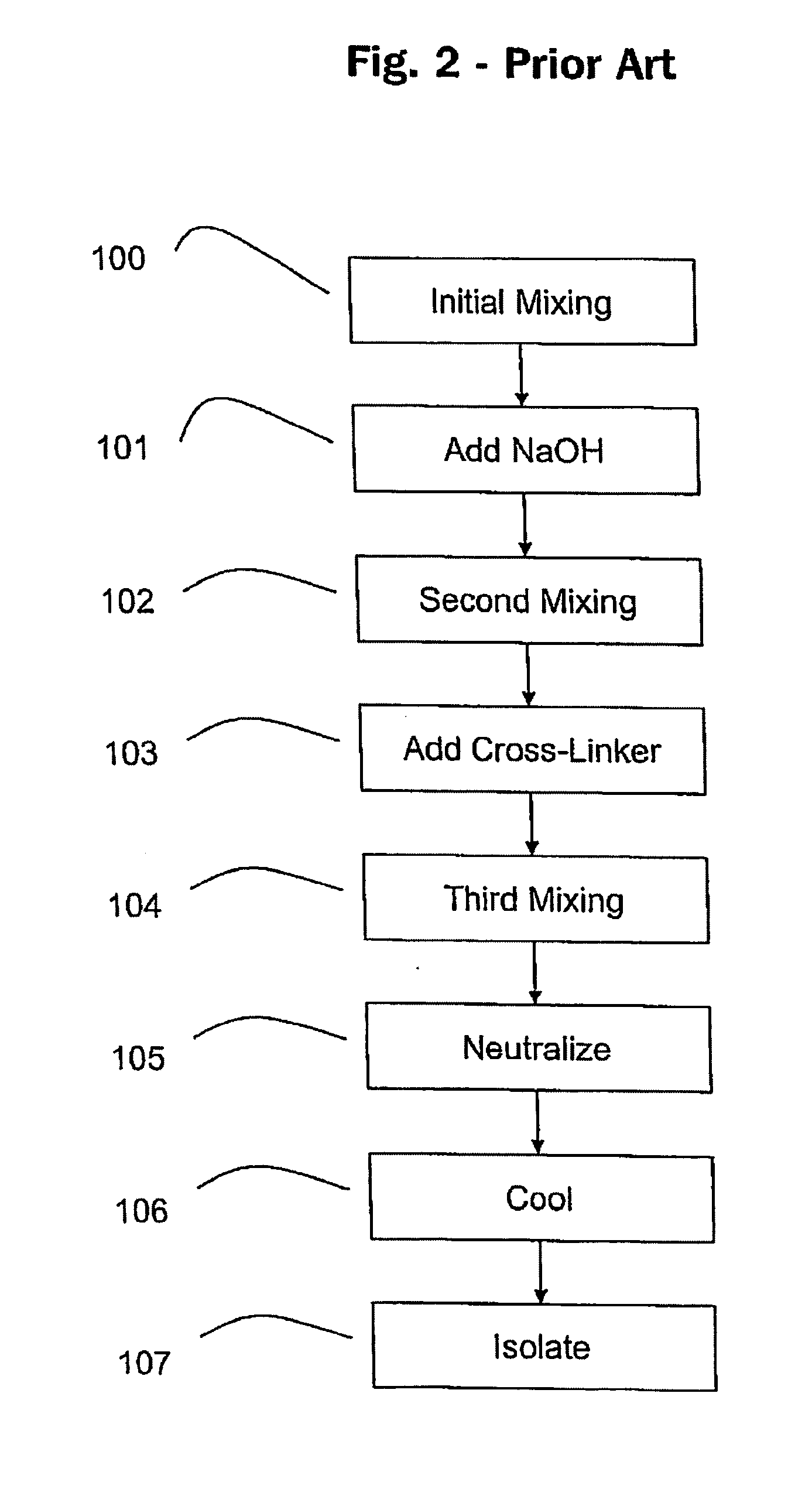Oxidized reversibly swelling granular starch products
a technology of oxidized reversible swelling and starch, which is applied in the field of resistant starch products, can solve the problems of excessive granule swelling, insufficient subsequent thickening efficiency, and dull taste of food products, and achieve the effect of increasing stability
- Summary
- Abstract
- Description
- Claims
- Application Information
AI Technical Summary
Benefits of technology
Problems solved by technology
Method used
Image
Examples
example 1
(a) Preparation of Pre-Swelled / Cross-Linked Starch
[0065] This example, as depicted in the flowchart of FIG. 2, describes the production of oxidized starch from granular pre-swollen / cross-linked wheat starch. In step 100, wheat starch (100 parts, dry basis) was dispersed in 233 parts of water with 2 parts of sodium sulfate and mixed. After mixing for 30 minutes, sodium hydroxide (1.5 parts) was added in step 101. The reaction mixture was heated to 45° C. and continuously mixed at that temperature for 2 hours in step 102. For efficient cross-linking, 3.8 parts of sodium trimetaphosphate, 0.038 parts of sodium polyphosphate and 3 parts of sodium sulfate were added together in step 103. After further mixing for 20 hours at 45° C. in step 104, the slurry was neutralized to pH 6.5 with dilute 1.0 N hydrochloric acid in step 105 and cooled to 25° C. in step 106. Starch was isolated by washing with water and spray drying in step 107.
(b) Preparation of Oxidized Pre-Swelled / Cross-Linked S...
example 2
[0070] Example 1 describes a two-step process for producing a starch of the invention. Alternatively, the two steps may be combined to produce a starch of the invention in a one-step embodiment, whether batch, semi-continuous or continuous. An example of such a process is depicted in the process flowchart of FIG. 4.
[0071] In step 100, wheat starch (100 parts, dry basis) is dispersed in 233 parts of water with 2 parts of sodium sulfate and mixed. After mixing for 30 minutes, sodium hydroxide (1.5 parts) are added in step 101. The reaction mixture is heated to 45° C. and continuously mixed at that temperature for 2 hours in step 102. For efficient cross-linking, 3.8 parts of sodium trimetaphosphate, 0.038 parts of sodium polyphosphate and 3 parts of sodium sulfate are added together in step 103. There is further mixing for 20 hours at 45° C. in step 104.
[0072] Thereafter, in step 201, pH is adjusted to 11.0 with 1 M sodium hydroxide. Sodium hypochlorite 7.5% (dry starch basis) is ad...
example 3
[0073] In this example a series of oxidized wheat starch products were made using a constant level of 7.5% (w / w, dry basis of starch) sodium hypochlorite at pH 11 for 16 hours. Three separate experiments were carried out at temperatures of 25° C., 35° C., and 45° C. The methods described in Example 1 for the preparation of the starch products were followed, as were the tests conducted in Example 1. The three oxidized starch products are compared to the non-oxidized starch prepared in Example 1 (a) in Table 1:
TABLE 1Swollen Volume Ratio (v / w)Water Hydration TestEmulsion Stability TestCold WaterHot WaterWater / (25° C.)(85° C.)StarchWaterStarch / OilS RSa1.53.85.23.6NegligibleS RS-Oxyb25° C.2.67.68.22.8Negligible35° C.2.37.17.82.6Negligible45° C.2.26.56.98.3Negligible
aSRS: Reversibly Swellable Resistant Starch
bSRS-Oxy: Oxidized Reversibly Swellable Resistant Starch
PUM
| Property | Measurement | Unit |
|---|---|---|
| Temperature | aaaaa | aaaaa |
| Temperature | aaaaa | aaaaa |
| Temperature | aaaaa | aaaaa |
Abstract
Description
Claims
Application Information
 Login to View More
Login to View More - R&D
- Intellectual Property
- Life Sciences
- Materials
- Tech Scout
- Unparalleled Data Quality
- Higher Quality Content
- 60% Fewer Hallucinations
Browse by: Latest US Patents, China's latest patents, Technical Efficacy Thesaurus, Application Domain, Technology Topic, Popular Technical Reports.
© 2025 PatSnap. All rights reserved.Legal|Privacy policy|Modern Slavery Act Transparency Statement|Sitemap|About US| Contact US: help@patsnap.com



